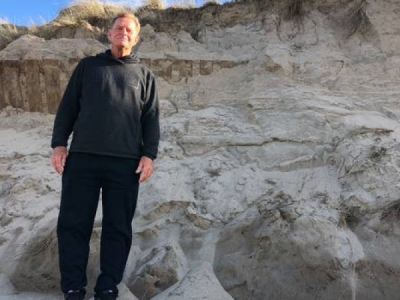
Posted on August 2, 2020
High seas and stormy weather across the North Island’s east coast has caused a surge of dune erosion from Whangamata to Pauanui Beach with locals saying New Zealand’s best beach Whangamata now has its own White Cliffs of Dover.
The dunes in Whangamata are over four metres high while the recent storms have carved the escarpment and revealed planks that locals say have been buried since the 1980s and 1990s.
Whangamata Motor Camp operator Sarah Ellery said it is unlike anything she has seen before at the beach, saying there was no easy access down to a section of the beach, while at high tide there was no beach at all.
“It’s between access eight and the surf club, it’s pretty brutal but we aren’t too concerned, you may be concerned if you had an expensive house on the beach front,” Ellery said.
“They are pretty high these dunes, we have had big seas and high tides recently. You can go down there and there is not much beach to sit on at high tide currently.
“Right now you have to go round past the surf club to get access to the beach, I went down last week and at its lowest you had to jump about half a metre to get down, so for older people and for the buggies it’s not really friendly for them either.”
Sarah said locals who had been at Whangamata for over 50 years said they had seen this happen before and were not concerned by the high dunes.
She said she hopes the sand dunes come back over summer, but was concerned on how the grass would come back to hold the dunes together.
“I don’t know how it works really, but I know the grass has gone with the erosion so hopefully something will be done about bringing the grass back.”
Waikato Regional Council said that dunes play an important role in protecting beaches from coastal erosion and sand inundation caused by a combination of massive storms and high tides.
Native dune plants trap wind-blown sand, building a natural buffer in the coastal margin and allowing the dunes to self-repair following big storm events.
To hold the dunes together, marram grass is planted annually which is vigorous tussock-forming grass that is very effective in trapping sand.
Due to Covid-19, the annual Coastcare planting season has started late this year, so Coastcare Waikato co-ordinators are keen to recruit more volunteers to help stabilise the dunes.
Waikato Regional Council site restoration adviser Moniqua Nelson-Tunley said there are there are nearly 70,000 plants to get into the foredunes and backdunes of beaches across the Waikato and Coromandel.
“Our dunes are fragile. More than 75 per cent of our region’s beaches have been modified or destroyed by removal, grazing or trampling of native plants. That’s why the work by our Coastcare volunteers is so important,” Nelson-Tunley said.
The Department of Conservation said they are working closely with the Thames-Coromandel District Council around monitoring the erosion at Whangamata after concerns were raised by locals.
“We are aware of the erosion at Whangamata, and the concern that is causing for the local community, many of whom are recreational beach users,” DoC’s Hauraki district operations manager Avi Holzapfel said.
“Beaches are naturally prone to cycles of erosion and rebuilding, and management of such events will not be straightforward.
“DoC is working with TCDC to further clarify roles and responsibilities for management of this coastline.”
Thames-Coromandel district council coastal scientist Jamie Boyle says the dune erosion is not a man made problem.
“The dune erosion is completely natural and the active dune that has lost sand is doing exactly what it should be doing and providing a buffer for wave energy. The area is being monitored and the beach accessway upgrades will occur once the current erosion event settles down.”
He said the stormwater upgrade work near Williamson Park would ease the increasing demand on this part of the network, and the current beach scarp evident along Esplanade Drive and other parts of the beach impacted by recent storms and swells would have “very little influence” from one stormwater outlet.
“We would expect a small amount of scour within 1-5m either side of an outlet, but not the area-wide erosion that is currently visible.”
Source: nzherald





